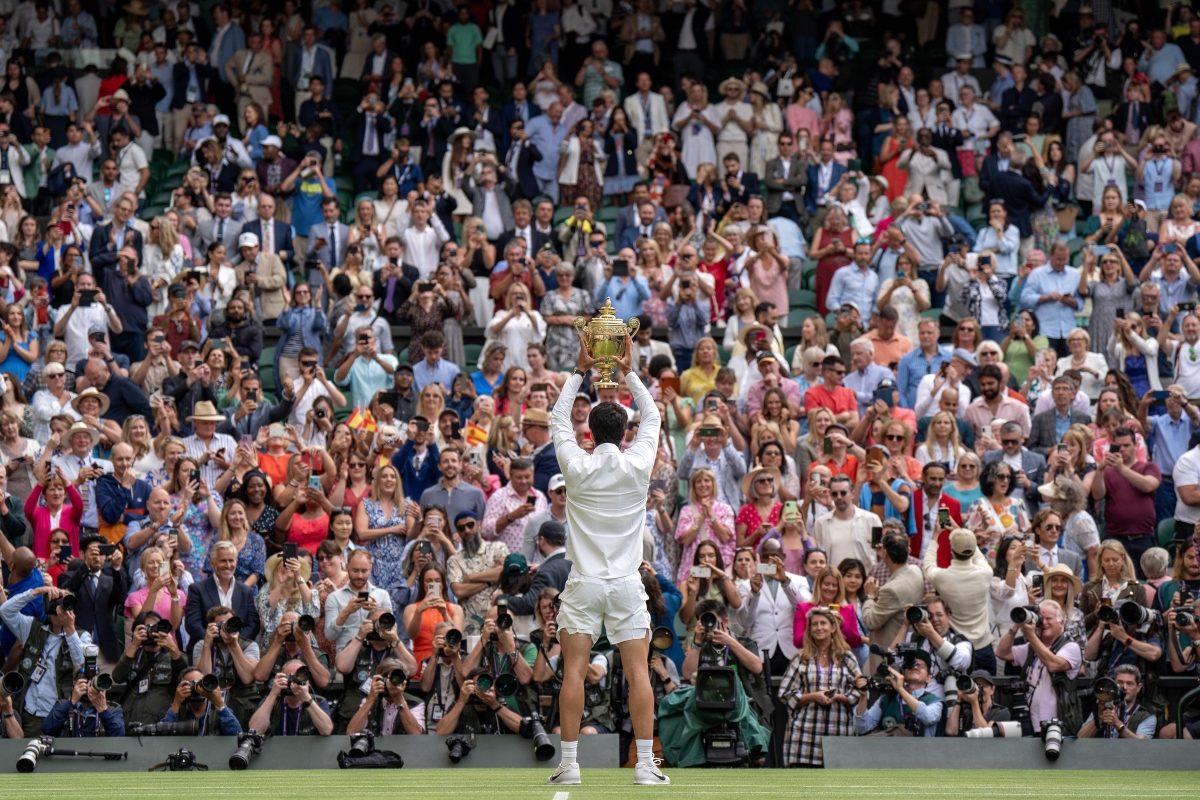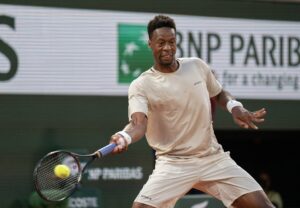The old saying in tennis was that winning any of the other Majors (the French, Australian or US Opens) would make you famous within the sport but winning Wimbledon would make you world-famous, full-stop. It was a testament to the singular nature of Wimbledon, which still simply and timelessly refers to itself as “The Championships”. Grass-court tennis in general is becoming increasingly rare, but that only adds to the unique difficulty of winning Wimbledon, the oldest of the four Majors and generally still regarded as the biggest.
So it is that Carlos Alcaraz, having already won his first Major at the US Open last September, is now coming to terms with winning Wimbledon, after his genuinely epic and indeed historic win over Novak Djokovic in Sunday’s men’s final. But where does his victory rank among the biggest breakthrough wins in Wimbledon men’s finals in the Open Era (since 1968)?
A breakthrough win is when a great player wins their first Wimbledon, usually by beating a great current or former champion in the process. Effectively, they announce the start of a new era and are usually followed by a succession of wins by that player – sometimes as many as five in a row.
Here, then, are the five biggest breakthrough Wimbledon wins of the Open era on the men’s side of the tournament – not in chronological order, but in order of impact on Wimbledon itself and tennis in general.
- Björn Borg beats Ilie Năstase (6–4 6–2 9–7) to win Wimbledon in 1976
In 1976, Björn Borg was already a two-time French Open champion and had only just missed out on a hat-trick of Roland Garros titles after losing to Italy’s Adriano Panatta in the quarterfinals of that year’s tournament. However, that dominance on clay only added to the suspicion that the Swede might not be able to cut it on grass, a suspicion that persisted until he won his first Wimbledon title in 1976, beating the original Bad Boy of Men’s Tennis, Romania’s Ilie Năstase, to begin his run of five successive titles at the All England Club.
Năstase was not the defending Wimbledon champion when Borg beat him; indeed, he had never won Wimbledon and never would win it. Nevertheless, he had won the US Open (in 1972) and the French Open (in 1973, the year before Borg won his first Roland Garros title), and he had narrowly lost one of the all-time great Wimbledon finals, the 1972 edition versus the USA’s Stan Smith. Consequently, in 1976 he was regarded as a significant obstacle for Borg to overcome. Nevertheless, the Swede showed all the froideur he would become famous for in virtually swatting Năstase aside, with only the third set proving problematic. In the era before Wimbledon adopted tie-breakers to end sets, Borg eventually won it 9-7 and thus began his domination of grass to go alongside his domination of clay.
- Andy Murray beats Novak Djokovic (6–4 7–5 6–4) to win Wimbledon in 2013
There is a strong case to be made that Andy Murray’s 2013 win at Wimbledon, the 10th anniversary of which was celebrated copiously at this year’s tournament, should be first in this list of breakthrough Wimbledon wins. That is because he had to overcome arguably the greatest pressure that has ever been placed on any sportsperson by Britain’s near-century-long longing for a male champion to follow Fred Perry’s final Wimbledon triumph in 1936.
The fact that Murray’s 2013 victory is only fourth in this list rather than in first is down to the fact that in 2013 Djokovic had yet to achieve the complete domination (or perhaps “Djomination”) of Wimbledon that would begin the following year with his first triumph in a final over Roger Federer. In 2013, Djokovic was the world #1 and the top seed at Wimbledon, but he was not quite as all-conquering on grass as he would become.
Indeed, Djokovic had only won one Wimbledon title up to that point (in 2011, when he beat the defending champion Rafael Nadal in the final) and had been beaten by Murray in straight sets a year earlier on the same court in the Olympic semifinals. Murray was able to beat him again in straight sets, with only the very last game of the match (in which Djokovic had several chances to break Murray’s serve and thereby prolong proceedings) proving particularly troublesome. It would be Djokovic’s last defeat on Centre Court for over a decade, a remarkable run that only ended this weekend.
- John McEnroe beats Björn Borg (4–6 7–6 (7–1) 7–6 (7–4) 6–4) to win Wimbledon in 1981
For all of the undoubted greatness of Carlos Alcaraz, it is doubtful that 40 years from now anyone will be making seminal documentaries or films about him, because he is such a charming, positive, lovable character. John McEnroe in the early 1980s was a complete contrast to Alcaraz in the early 2020s, being irritable, querulous and seemingly utterly conflicted between his obvious genius for tennis and his apparent inability to enjoy that gift. That is why he has been the subject of arguably the greatest documentary about tennis ever made (In The Realm of Perfection, 2018) and unarguably the greatest film about tennis ever made (Borg vs McEnroe, 2017).
So much of the “Mac” legend is rightly focused on his 1980 Wimbledon final against Björn Borg, which for nearly three decades (and another legendary Wimbledon final that is examined below) was regarded as the greatest tennis match ever played. Borg won in 1980 to secure his fifth Wimbledon title in a row, but a year later McEnroe gained his revenge by finally beating Borg in four sets to secure his own first Wimbledon title. He would win Wimbledon twice more, against New Zealand outsider Chris Lewis in 1983 and fellow American legend Jimmy Connors in 1984, but it was his 1981 victory, in which he finally shattered the ice-man that Borg had come to be seen as, that was his breakthrough Wimbledon triumph.
- Rafael Nadal beats Roger Federer (6–4 6–4 6–7 (5–7) 6–7 (8–10) 9–7) to win Wimbledon in 2008
Obviously comparisons have been made between Carlos Alcaraz’s triumph over Djokovic this weekend and Rafael Nadal’s victory over Roger Federer in 2008, because both men are Spanish. Far more importantly, however, they both defeated an opponent who had been thought virtually unbeatable, at least on Centre Court. For Djokovic in 2023, read Roger Federer in 2008 – only more so.
Federer had equalled Borg’s record of five successive Wimbledon wins in 2007, when he beat Nadal for the second successive time in a Wimbledon final. Consequently, Federer was going for a record-breaking sixth Wimbledon title in succession when he again faced Nadal in the 2008 final. However, Nadal had clearly learned from his two previous losses in the Wimbledon final to Federer and was absolutely determined not to make it a hat-trick of defeats. In what has come to be regarded almost universally as the greatest tennis match ever played, overtaking Borg-McEnroe in 1980, Nadal eventually won 9-7 in the fifth set, in the kind of fast-gathering gloom that was once an inescapable part of Wimbledon but would never be seen again following the addition of a roof on Centre Court a year later.
1.Carlos Alcaraz beats Novak Djokovic (1-6 7-6 (8-6), 6-1 3-6 6-4) to win Wimbledon in 2023
Unlike McEnroe and Nadal in 1980 and 2008 respectively, Alcaraz was not playing a five-times-in-a-row Wimbledon winner when he beat Djokovic this weekend, but he might as well have been, given Djokovic’s almost complete annexation of the tournament over the last decade, winning seven titles in total between 2011 and 2022. (Indeed, Djokovic might well have won Wimbledon five times in a row if the 2020 tournament had not been cancelled because of the Covid pandemic.)
Consequently, Alcaraz faced the ultimate obstacle to a Wimbledon title in Djokovic, so much so that his 2023 triumph deservedly ranks ahead even of those by McEnroe in 1981 and Nadal in 2008. As aforementioned, Djokovic had not lost a match on Centre Court since the 2013 final (his defeats at Wimbledon in 2016 and 2017 came on other courts); he was attempting to equal Federer’s all-time record total of eight Men’s Singles titles; and he was also on course to complete the Calendar Grand Slam (i.e. the actual Grand Slam) of winning all four Majors in a single calendar year, having already won in 2023 in Melbourne and Paris.
In addition, Alcaraz was also facing his own Djokovic-related demons, after completely cramping up against him in the French Open semifinal last month and later admitting that that was at least in part due to the enormous nerves that he had felt at facing Djokovic in a Major for the first time. Moreover, he was only playing his fourth grass-court tournament ever, whereas Djokovic had already won Wimbledon, the greatest grass-court tournament of them all, seven times.
All of that only puts Alcaraz’s 2023 victory in its proper historical context. McEnroe and Nadal may have beaten five-times Wimbledon winners in 1981 and 2008 respectively, but they had both at least reached Wimbledon finals before (twice in Nadal’s case). By contrast, Alcaraz was a virtual newcomer to grass, playing against arguably the greatest grass-court player ever, who had not just beaten him but virtually frightened him into submission at another Major just over a month earlier.
Prior to this year’s Wimbledon, I had written after Alcaraz’s triumph at Queen’s that he had already proven himself to be a spectacularly fast – indeed “hypersonic” – learner throughout his short career so far and that if anyone could beat Djokovic at Wimbledon, it was him. Alcaraz proved all those premonitions correct and in the process achieved what must be regarded as the greatest ever breakthrough win by a man at Wimbledon since the Open Era began.
Main photo credit: Susan Mullane-USA TODAY Sports






